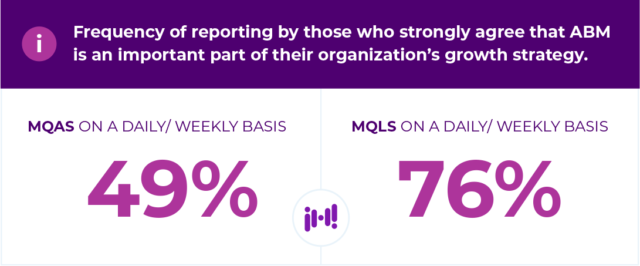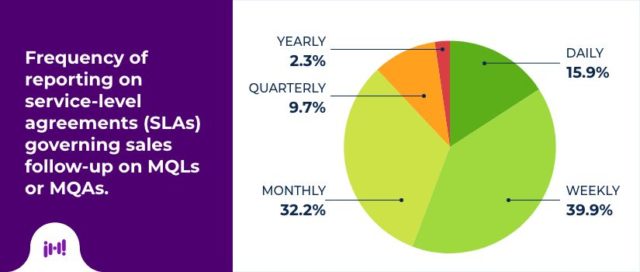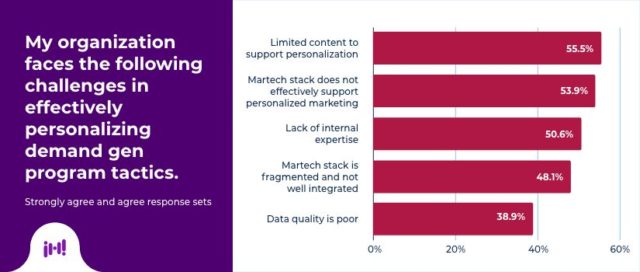Blog

Every marketing leader knows the importance of marketing benchmarks. Understanding what your marketing team does is critical, but knowing how what you’re doing compares to peers can validate your approach or call it into question. Ultimately, for an organization to successfully grow, you need both.
Iron Horse’s most recent primary research project focuses exclusively on senior directors and higher in marketing programs, campaigns, and executive management at $100M+ B2B high tech and software companies headquartered in the United States. Pretty precise, right? That’s important because the way high-tech enterprises go to market, allocate their marketing dollars and work alongside sales is fundamentally different from SMBs, or even B2B enterprises focused on industrial manufacturing, let alone B2C marketing teams.
You can find all the results in our State of Enterprise B2B Technology Marketing: 2022 Benchmark Results report. Here are three key findings that are captivating and challenge conventional B2B marketing thought.
ABM is held back by a focus on MQLs.
Marketing qualified leads continue to be the preeminent measurement of marketing success in demand generation, even when ABM is a key lever of the organization’s growth strategy. Should this be the case? No! Continuing to focus on individual leads rather than accounts communicates that the executive team is continuing to prioritize leads, preventing marketers from fully embracing an account-based approach. Additionally, the conversion rates of MQLs does not reflect the rate of conversion of accounts, providing a skewed picture of what is working, and what isn’t and making it difficult to evaluate and optimize ABM programs.

Nonetheless, 76% of respondents who strongly agreed that ABM is an important part of their organization’s growth strategy measure MQLs on a daily or weekly basis, while only 49% do the same for MQAs.
The Iron Horse insight.
To change marketing’s behavior, we need to change what the organization measures. And if ABM truly is a primary lever for marketing success it must be measured and reported on as frequently and with the same level of focus (or more) as traditional marketing measurements (like the MQL).
SLAs are present, but enforcement wanes.
Governance reporting to ensure marketing-generated leads are engaged in a timely manner is a core component of any lead management system. It’s important because leads that are engaged in a more rapid timeframe convert at a higher rate than leads engaged following a structured approach.

The survey indicates that 16% of respondents review SLAs compliance daily, followed by 40% on a weekly basis. That’s great! What’s not so great is the 32% that indicated they review SLA compliance on a monthly basis. Worse is the 10% of respondents who check out SLAs quarterly and the 2% that only do this yearly. In both these cases, the SLA review takes place well beyond the time when missed actions can be taken.
The Iron Horse insight.
Retaining and growing customers is more cost effective to an organization than seeking net-new logos. In the same way, increasing the percentage of qualified marketing leads engaged by sales (or maintaining a high rate of engagement) is more cost effective than “simply” generating more leads with a lower engagement rate. It also helps an organization to scale faster and more predictably. Rather than focusing on getting “more” leads, first ensure the leads marketing generates are consistently being engaged within SLAs. If not, start there!
Personalization is less impacted by data and actually more constrained by content.
How often do you receive emails pushing services that are irrelevant to your role or company? How about services you already have? Does having your name or company name in the subject line make these offers any more relevant to you? What about an intro congratulating you on a recent promotion, or commiserating with the challenges of “being a marketing leader”?
Would you call this outreach personalized?
I wouldn’t. What’s more, those emails go right into the trash.
Personalization is a critical level in B2B technology marketing, but regardless of how well we proclaim our marketing programs are successful at it, personal experience says most marketing teams are not.
The challenges reported by respondents provide a window into this disconnect. More than half of respondents cited lack of content, incomplete martech stack, or a lack of internal expertise as a barrier to effective personalization. But, what surprised me was that respondents were significantly less likely to cite data quality as a challenge than limited content.

After years of attention to the “data problem,” it appears that marketers finally feel like they have the insights they need, and are ready to focus on using them well.
The Iron Horse insight.
There are two facets of personalization that need to be taken into consideration and both are equally important. The first is understanding how you should be engaging with prospects and customers: What does it really mean to provide a personalized experience? The second is the technical strategy for actually operationalizing this engagement. You need both, and without one or the other the ability to orchestrate a cohesive, humanized experience across channels, and especially between marketing and sales, will remain elusive.
We’ll be exploring more 2022 tech marketing benchmarks in the upcoming weeks. Download the report to explore all the findings and stay informed about upcoming events, including our coffee break discussion between Iron Horse CEO Uzair Dada and Demandbase’s Jon Miller and our session at the ON24 Checkpoint Summit on August 24.
Subscribe to our blog.
Get unstuck with the most interesting business ideas and our insights delivered to your inbox.